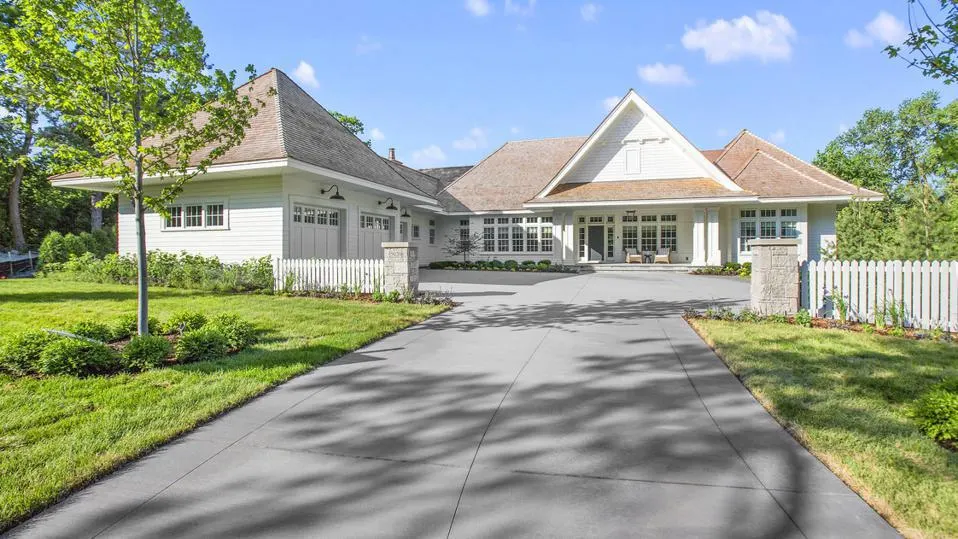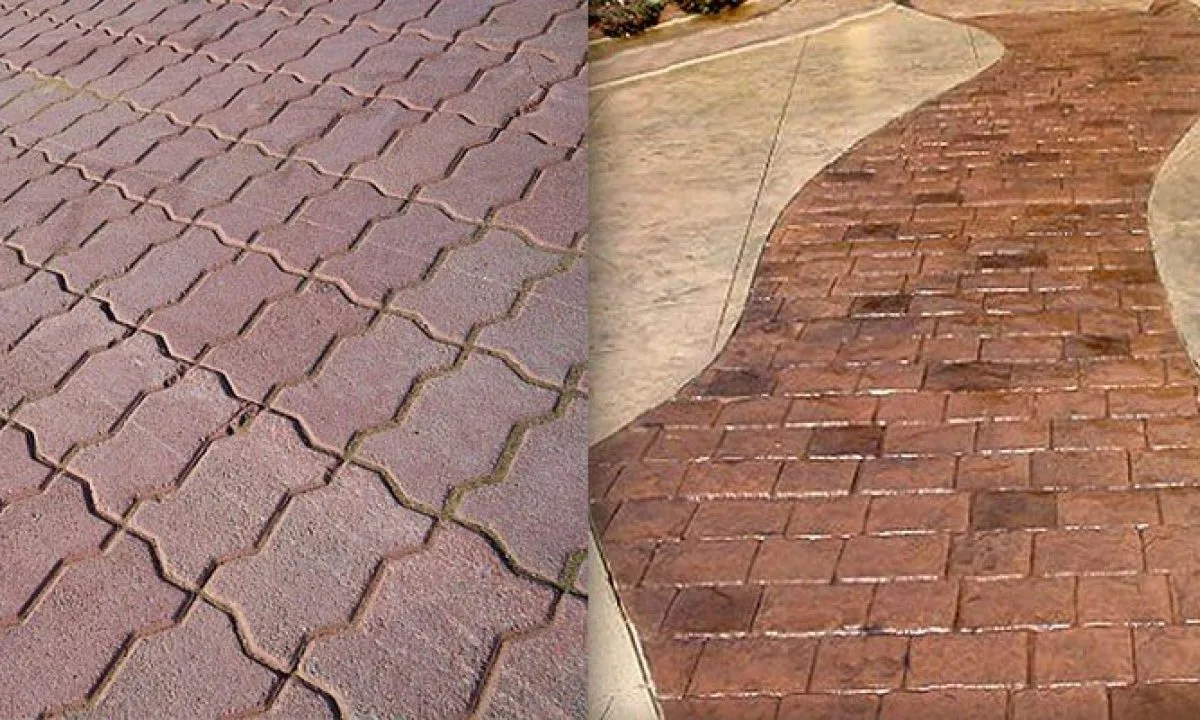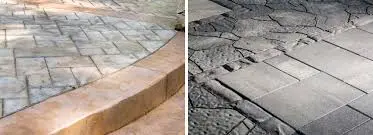Creative Concrete Transformations: Decorative Styles
Stamped Concrete Patterns and Designs
Stamped concrete offers a versatile and affordable way to enhance the appearance of outdoor surfaces such as driveways, patios, and walkways. Here are some popular stamped concrete patterns and designs:
Ashlar Slate: Ashlar slate is a popular stamped concrete pattern that mimics the look of natural stone. It features irregularly shaped stones arranged in a random pattern, creating a rustic and textured surface that adds character to any outdoor space.
Cobblestone: Cobblestone-stamped concrete resembles the classic look of old-world cobblestone streets. This pattern features small, rounded stones arranged in a grid or random pattern, creating a timeless and elegant appearance.
Herringbone: Herringbone stamped concrete is characterized by a zigzag pattern of interlocking rectangular shapes. This classic design adds visual interest and texture to outdoor surfaces, making it a popular choice for driveways, patios, and walkways.
Wood Plank: Wood plank-stamped concrete replicates the look of natural wood, complete with grain patterns and texture.
Brick: Brick-stamped concrete creates the timeless look of traditional brick pavers with the added benefits of durability and affordability. This pattern is available in various colors and styles, allowing property owners to customize the look to suit their preferences.
Cobblestone Circle: Cobblestone circle patterns add visual interest and focal points to outdoor surfaces. These circular designs can create decorative accents, such as centerpieces for driveways or patios, adding a touch of elegance to the landscape.
Stamped concrete patterns and designs offer endless possibilities for enhancing outdoor spaces with style and creativity.

Stained Concrete Techniques
Stained concrete is a popular and versatile flooring option with various colors, patterns, and effects. Here are some standard stained concrete techniques:
Acid Staining: Acid staining is a popular technique for adding color and depth to concrete surfaces. Acid stains are available in various earthy tones, such as browns, greens, and blues, allowing endless customization options.
Water-Based Stains: Water-based stains offer a more predictable and uniform coloration than acid ones. These stains penetrate the surface of the concrete and can be layered or mixed to create custom colors and effects. Water-based stains are available in various hues, from vibrant blues and reds to subtle earth tones and neutrals.
Dyeing: Concrete dyes are highly pigmented liquids that penetrate the pores of the concrete, creating intense, vibrant colors. Dyes offer excellent color consistency and can be used to achieve bold, solid colors or intricate patterns and designs. They are often used with acid—or water-based stains to create custom effects.
Scored and Stained Concrete: Scored and stained concrete combines decorative scoring or saw-cutting techniques with staining to create intricate patterns and designs. By scoring the concrete before staining, property owners can achieve the look of tile, brick, or even intricate geometric patterns, adding visual interest and texture to the surface.
Overlay Staining: Overlay staining involves applying a thin layer of overlay material to existing concrete surfaces before staining. This technique creates smooth, uniform surfaces and provides a blank canvas for staining, enabling property owners to achieve consistent coloration and precise detailing.
Stained concrete techniques offer endless possibilities for enhancing interior and exterior surfaces with color, texture, and style.
Custom Concrete Colors and Pigments
Custom concrete colors and pigments allow property owners to personalize their surfaces and create unique, eye-catching designs. Property owners can achieve various hues and effects to complement any style or aesthetic by adding color to concrete through integral pigments, stains, or dyes. Here's what you need to know about custom concrete colors and pigments:
Versatility: Custom concrete colors and pigments provide endless possibilities for customization. Property owners can choose from various colors, shades, and tones to match existing decor, create bold statements, or achieve specific design objectives.
This method offers durability and long-lasting color that won't fade or wear away over time.
Stains and Dyes: Stains and dyes are applied to the surface of cured concrete.
Customization Options: Property owners can achieve virtually any color imaginable with custom concrete colors and pigments. Whether you're looking for subtle earth tones, vibrant primary colors, or metallic finishes, there's a custom color or pigment option to suit your needs.
Aesthetic Appeal: Custom concrete colors and pigments enhance the aesthetic appeal of concrete surfaces, turning ordinary slabs into works of art. Whether indoors or outdoors, custom colors and pigments add warmth, vibrancy, and visual interest to any space.
Longevity and Durability: Custom-colored concrete surfaces maintain their color and appearance for years, requiring minimal maintenance when properly installed and sealed.
Innovative Concrete Formwork
Concrete formwork is crucial in shaping and supporting concrete structures during construction. Innovative concrete formwork techniques and materials have revolutionized building concrete structures, offering increased efficiency, sustainability, and design flexibility. Here's a closer look at some of the latest innovations in concrete formwork:
Prefabricated Formwork Panels: These panels are designed to precise specifications, ensuring consistent quality and dimensions. Prefabricated formwork panels save time and labor costs, speeding up the construction process and improving productivity.
Engineered Wood Formwork: Engineered wood formwork, such as plywood or oriented strand board (OSB), offers a sustainable and cost-effective alternative to traditional lumber formwork. Engineered wood formwork is lightweight, strong, and dimensionally stable, making it ideal for forming complex shapes and structures.
3D-Printed Formwork: 3D-printed formwork is a cutting-edge technology that uses additive manufacturing techniques to create custom formwork molds.
Flexible Formwork Systems: Flexible formwork systems are designed to bend and shape to create curved or irregular concrete structures. Made from flexible plastic or rubber materials, they offer versatility and adaptability, allowing innovative and creative design solutions.
By embracing these innovations, construction professionals can achieve faster construction times, lower costs, and more innovative and aesthetically pleasing concrete structures.
Decorative Concrete Overlays
Decorative concrete overlays are a versatile and cost-effective solution for transforming existing concrete surfaces into beautiful and functional spaces. Property owners can rejuvenate worn or outdated concrete surfaces by applying a thin layer of overlay material, adding color, texture, and pattern to achieve a custom look. Here's what you need to know about decorative concrete overlays:
Versatility: Decorative concrete overlays can be applied to various surfaces, including driveways, sidewalks, patios, pool decks, and interior floors.
Enhanced Durability: Decorative concrete overlays are designed to withstand heavy foot traffic, UV exposure, and harsh weather conditions. They provide a durable, long-lasting solution for protecting and beautifying concrete surfaces, extending their lifespan and reducing maintenance requirements.
Design Options: Decorative concrete overlays offer endless design options, including stamped patterns, textured finishes, and custom colors.
Quick Installation: Decorative concrete overlays can be installed relatively quickly, minimizing downtime and inconvenience for property owners. Overlays can frequently be put directly over pre-existing concrete surfaces, saving time and money by removing the requirement for thorough site preparation.
Low Maintenance: Decorative concrete overlays require little upkeep after installation to maintain their finest appearance. Periodic resealing and routine cleaning are advised to protect the surface and preserve its beauty over time.
Decorative concrete overlays offer a versatile, durable, cost-effective solution for transforming existing concrete surfaces into stunning and functional spaces. Whether you're looking to enhance your home's curb appeal or update the look of a commercial property, decorative concrete overlays provide endless design options and benefits for property owners.
Sustainable Concrete Design Elements
Sustainable concrete design elements are innovative solutions that prioritize environmental responsibility while providing durable and aesthetically pleasing structures. Property owners can reduce their ecological footprint and contribute to a more eco-friendly built environment by incorporating sustainable design elements into concrete projects. Here are some critical sustainable concrete design elements:
Recycled Materials: Using recycled resources in concrete mixes, such as fly ash, slag, and recycled aggregates, minimizes waste and lowers the need for virgin materials. Recycled materials can be used as substitutes for traditional aggregates and cement, reducing the environmental impact of concrete production.
Low-Carbon Concrete: Low-carbon concrete mixes use substitute cementitious elements, such as supplemental cementitious materials (SCMs) and alternative binders, to lessen the carbon footprint of concrete manufacturing. Using less energy-intensive materials, low-carbon concrete helps mitigate greenhouse gas emissions associated with cement production.
Porous Concrete: Permeable concrete, or pervious or porous concrete, allows water to infiltrate the surface and recharge groundwater supplies. It reduces stormwater runoff, minimizes erosion, and helps prevent flooding, making it an eco-friendly solution for driveways, parking lots, and sidewalks.
Cool Pavements: Cool pavements reflect sunlight and reduce heat absorption, mitigating the urban heat island effect and lowering ambient temperatures. Property owners can create more relaxed and comfortable outdoor spaces by incorporating light-colored aggregates, reflective coatings, or unique surface treatments into concrete pavements.
Energy-Efficient Design: Reducing heating and cooling loads by using energy-efficient design components in concrete structures, such as thermal mass insulation, and using passive solar solutions reduces the building's lifetime running expenses and energy consumption.
Summary
To sum up, sustainable concrete design features provide creative ways to lessen the adverse effects of concrete construction on the environment while enhancing its strength, usefulness, and beauty. By adopting sustainable design concepts, building owners may build long-lasting, durable structures that respect the environment and save money. Let's freely contact us. CALL US ANYTIME (720) 410-5198




